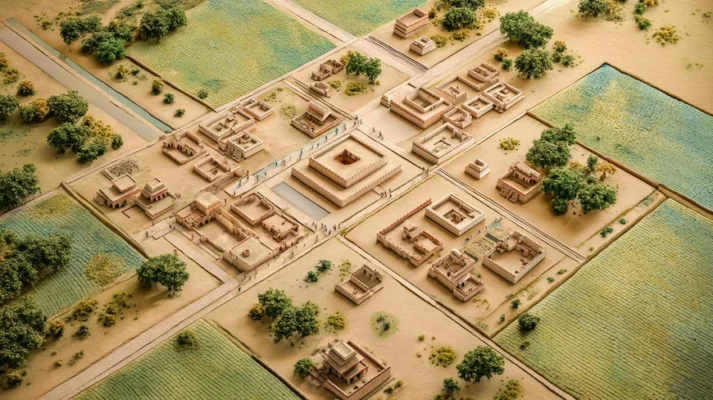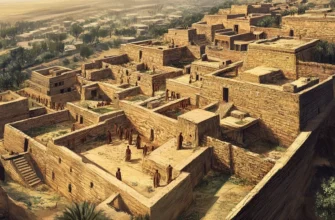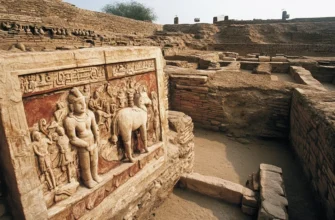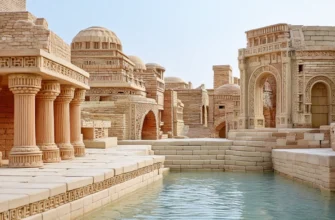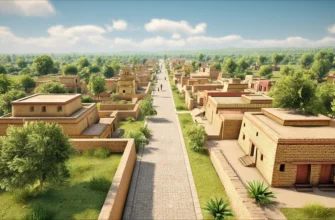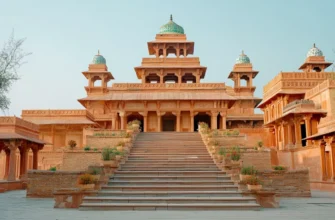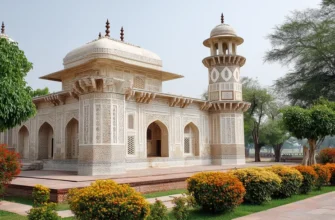Lothal is one of the most important cities of the Indus civilization, located in the modern state of Gujarat in India. The city is known for its archaeological finds and developed infrastructure, which testify to the high level of development of the ancient Indians.
Lotala was an important trading center located on the banks of a river, which allowed it to actively trade with other civilizations. Excavations in Lotala have uncovered numerous artifacts, including coins, pottery, and other household items, confirming the high level of craftsmanship of its inhabitants.
The architecture of the city is particularly interesting, including its well-planned streets, buildings, and water systems, which testify to the knowledge of engineering.
However, around 1900 BC, the city fell into decline. The reasons for this are not fully understood, but they are likely related to natural disasters or climate change. Today, Lothal is an important archaeological site and a popular destination for tourists who want to learn more about ancient Indian civilization.
History of Lothal
Lothal is one of the key cities of the ancient Indus civilization, which existed about 4,500 years ago. It is located in western India, in the area of the modern state of Gujarat, near the Sabarmati River.
The city became an important commercial and cultural center at the turn of the third and second millennia BC, when the Indus civilization reached its peak.
Location and discovery of the city
Lothal was discovered in 1954 during archaeological excavations in India. Archaeologists found numerous artifacts that confirmed the existence of a highly developed civilization. Immediately after the discovery, archaeologists drew attention to the specific geographical location of Lothal, as the city was located on trade routes connecting western India with Mesopotamia, allowing the city to flourish through international trade.
The beginning of prosperity and development
Lothal flourished as an important port city on the riverbank and was part of a large network of cities of the Indus civilization.
Its inhabitants had a well-developed infrastructure, including huge water reservoirs, sewage systems, and streets crisscrossing the city, which shows a high level of urban planning. This allowed not only trade links to be maintained, but also a high standard of living for the city’s inhabitants.
The city became an important center for the manufacture of goods such as jewelry, ceramics, and other crafts, which were actively traded with other cultures. Lothal was known for its ability to trade with countries as far away as Mesopotamia, where artifacts confirming this trading activity have been found.
This period of Lothal’s prosperity dates back to 2300-1900 BC, when the Indus civilization was at the peak of its development.
Archaeological finds in Lothal
Archaeological excavations at Lothal have provided unique evidence of the level of development of the Indus civilization and its ability to organize, trade, and manufacture handicrafts. The city was excavated in the mid-20th century, and since then, scientists have found numerous artifacts that provide insight into the daily life, technology, and culture of its inhabitants.
City plan and development
One of the greatest archaeological treasures is the city’s well-organized infrastructure. Lothal had a clear street plan with streets intersecting at right angles, indicating a high level of urban planning. Preserved fragments of buildings, streets, and street systems help us understand how the city functioned. In addition, archaeologists have found numerous kilns and workshops, confirming the high technological skills of its inhabitants.
Technology and crafts
One of the important archaeological finds in Lothal are numerous ornaments and jewelry made of precious metals and stones. The rings, bracelets, and beads made of copper, gold, and various materials such as carnelian and agate demonstrate the high level of skill of Lothal’s jewelers. This indicates a high level of craftsmanship and connections with other cultures, particularly Mesopotamia, as similar items have also been found in excavations in that region.
In addition, archaeologists have found numerous ceramic artifacts, including both household and ritual items. The high-quality ceramics from Lothal are characterized by a variety of ornamentation that demonstrates the cultural characteristics of this civilization.
Transportation links and trade
Archaeological evidence that Lothal was an important trading port is particularly significant. The discovery of harbors and docks, as well as the remains of goods such as seashells and pearls, indicate extensive trade links with other civilizations, particularly Mesopotamia, Persia, and Central Asia. This confirms that Lothal was actively trading in goods such as jewelry, textiles, ceramics, and other household items.
Archaeological evidence also indicates that Lothal had a developed water system. Large reservoirs and canals have been discovered, which were probably used for water storage or irrigation, allowing the city to function in the arid conditions of the region.
Thus, the archaeological finds of Lothal not only confirm the high level of civilization of the Indus Valley, but also show the importance of this city as a commercial, cultural, and technological center of its time.
The decline of Lothal
The decline of Lothal is one of the most mysterious and important topics for archaeologists and historians, as the reason for its decline remains a subject of debate. However, archaeological research and analysis of the materials found allow us to put forward several possible reasons for the decline of this important city.
Reasons for the decline of the city
Climate change
One of the most likely causes of Lothal’s decline is climate change. Archaeologists suggest that the region may have experienced severe droughts or changes in river flows that affected the city’s ability to support its population. In particular, the disappearance or drying up of waterways used for trade and irrigation could have led to economic decline and a lack of resources to sustain life.
Changes in trade routes
Another possible reason for the decline of Lothal is changes in trade routes. Lothal was an important trading port, but over time, changes in trade directions or the opening of new ports may have reduced Lothal’s role in international trade. This could have had a significant impact on the city’s economy, which was based on the exchange of goods with other cultures.
Social and political changes
Some researchers suggest that changes in the social or political structure of the city may have caused its decline. Perhaps economic downturns or internal conflicts led to a weakening of administrative power, which could also have contributed to the decline. In addition, increased competition from other cities or changing political conditions in the region may have been a factor in the decline of Lothal.
Natural disasters
The possibility of natural disasters such as earthquakes or floods cannot be ruled out, as these could have seriously damaged Lothal’s infrastructure, leading to its decline. Archaeologists have found no concrete evidence of such disasters, but similar phenomena could have contributed to the city’s rapid decline.
Archaeological evidence of decline
Excavations at Lothal indicate a gradual decline of the city. Archaeological layers show that between 1900 and 1800 BC, the number of residential buildings decreased significantly, and activity in trade and craft workshops declined. Pottery and other household items became less diverse, and the settlement lost its former size.
In addition, some parts of the city were abandoned, while others were almost completely neglected, which also supports the assumption of the gradual decline of Lothal as a large urban center.
The decline of Lothal is a complex and multifaceted process, and although the specific causes of its decline have not yet been clearly established, they probably include climate change, changes in trade routes, social and political changes, and possible natural disasters. This period in Lothal’s history is important for understanding the reasons for the decline of the great Indus civilization and its legacy.
The modern significance of Lothal
Although Lothal disappeared as a residential center more than 4,000 years ago, it remains an extremely important site for archaeological and historical research.
Today, the city is of great importance to science, culture, and tourism, and is also an important symbol of the heritage of ancient India.
Tourism and research
Lothal attracts tourists and researchers from all over the world as it is one of the largest archaeological sites of the Indus civilization.
Tourists can see the ruins of this ancient city, explore the preserved parts of its architecture, water reservoirs, hydraulic systems, and trading areas. The city has become an important tourist destination where you can learn more about how ancient Indian cities functioned.
Archaeologists and historians are actively researching Lothal, trying to uncover more facts about the lives of its inhabitants, their culture, technology, and social structure. Finds such as jewelry, pottery, and other artifacts are constantly adding new details to the history of the Indus civilization. Modern research also helps to understand Lothal’s role in global trade at the time and its influence on neighboring cultures.
Lothal as a cultural heritage
Lothal has become a symbol of India’s cultural heritage. It is part of the Indus civilization, one of the oldest civilizations on Earth. The city is not only important for archaeology, but also for understanding ancient Indian traditions, technologies, arts, and crafts. Today, Lothal is part of India’s national history, and studying it provides a better understanding of the development of society in prehistoric India.
Environmental and engineering achievements
One of the important aspects of Lothal’s modern significance is its engineering achievements, especially in the field of water supply and irrigation. The water collection systems, reservoirs, and canals found during excavations are impressive examples of the engineering skills of the ancient inhabitants of Lothal. These archaeological sites help modern scientists study ancient engineering solutions and apply them in modern conditions.
Preservation and protection
Today, Lothal is a protected and preserved site. The Indian government actively supports archaeological research and restoration work to preserve this important cultural heritage for future generations. The development of an archaeological park, tourist routes, and educational programs helps raise awareness of Lothal’s significance in human history.
The modern significance of Lothal lies not only in its archaeological value, but also in its importance as a symbol of India’s cultural heritage. Today, Lothal continues to be studied, protected, and used as a source of knowledge about the ancient Indus civilization, as well as a tourist and educational attraction.
Conclusion
Lothal is one of the most important cities of ancient India, which played a key role in the development of the Indus civilization. This city is a symbol of the high level of urban planning, technological achievements, and cultural prosperity of that time.
With its numerous archaeological remains, Lothal helps the modern world better understand the social structure, economy, and crafts of the ancient Indians.
Archaeological finds such as advanced infrastructure, water supply technologies, trade routes, and crafts confirm that Lothal was an important trading center at the crossroads of cultures and commercial ties between different civilizations. The loss of this city not only marked the decline of one of the greatest ancient cultures, but also provided lessons for studying the development and fall of ancient cities in the context of natural and social change.
Today, Lothal continues to be an important site for archaeological research and cultural heritage in India. Its significance for Indian history goes beyond archaeology and influences our understanding of global processes of civilizational development.
